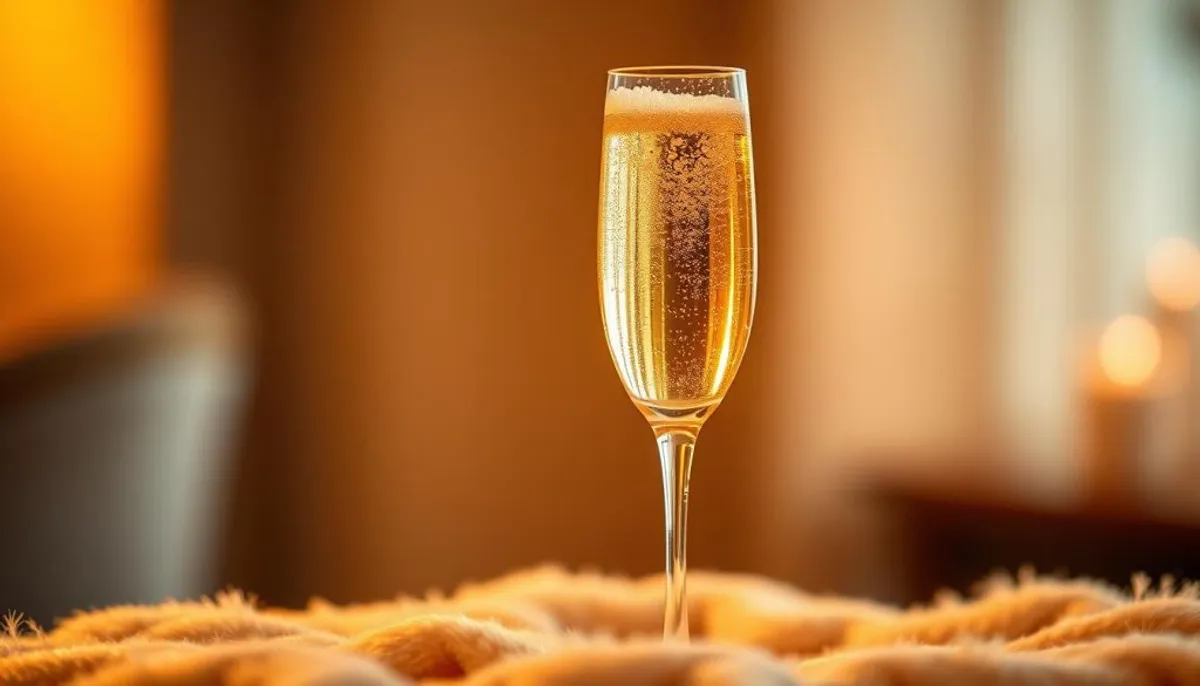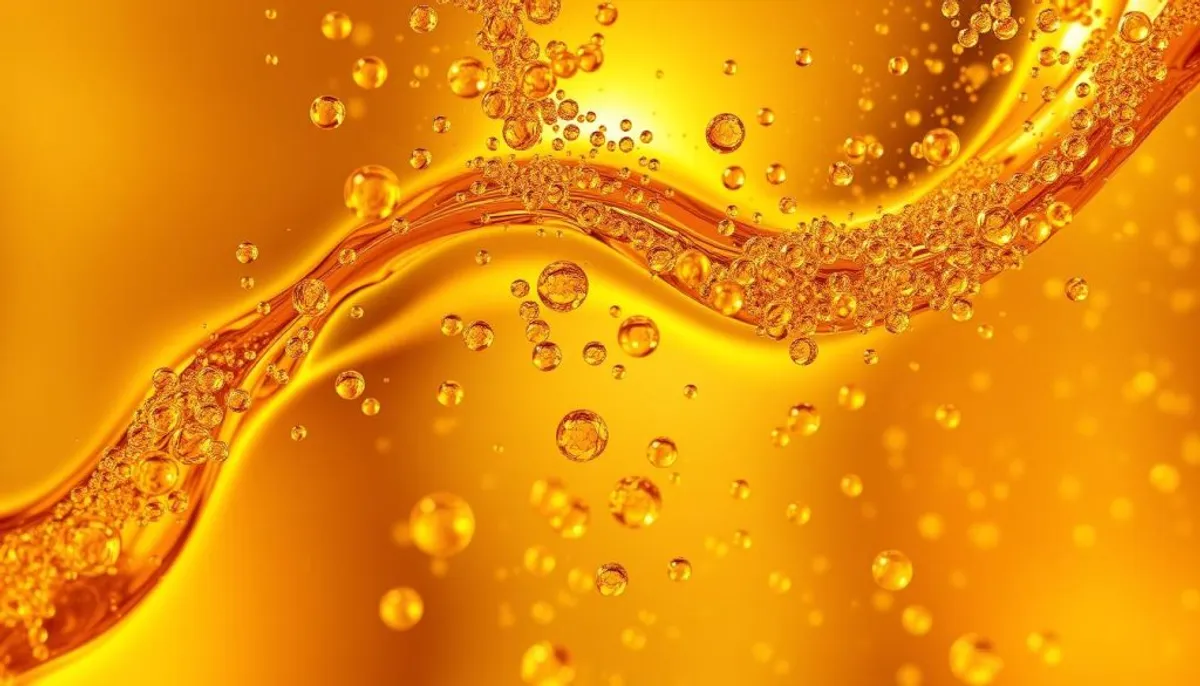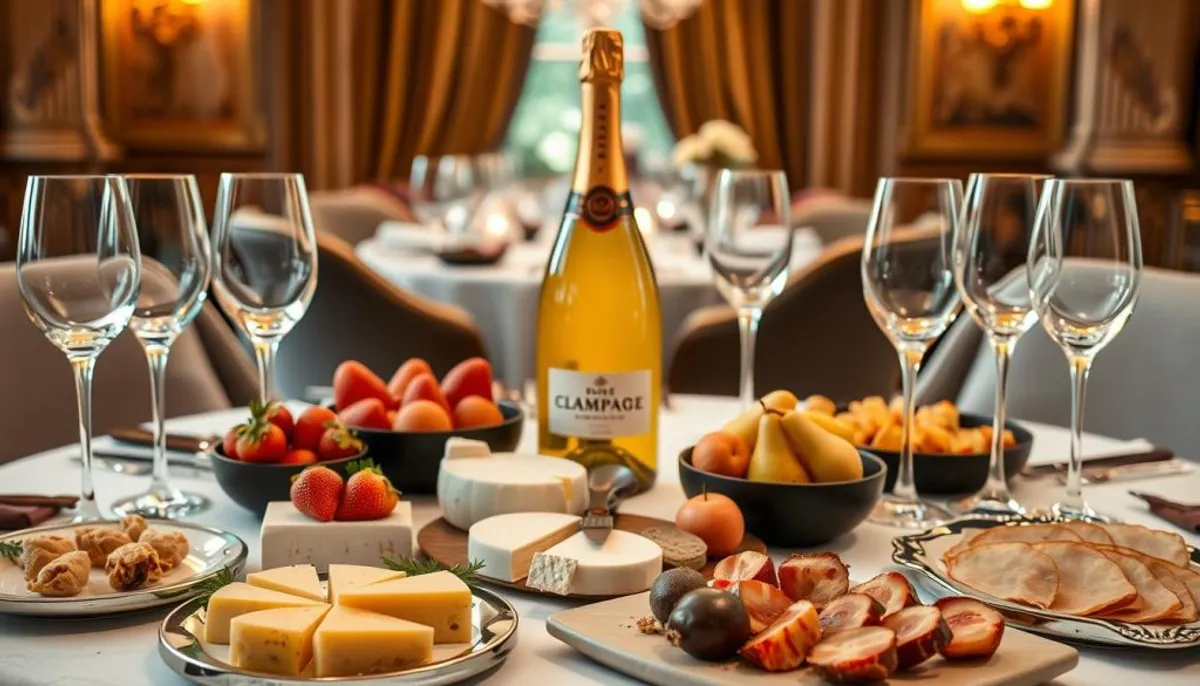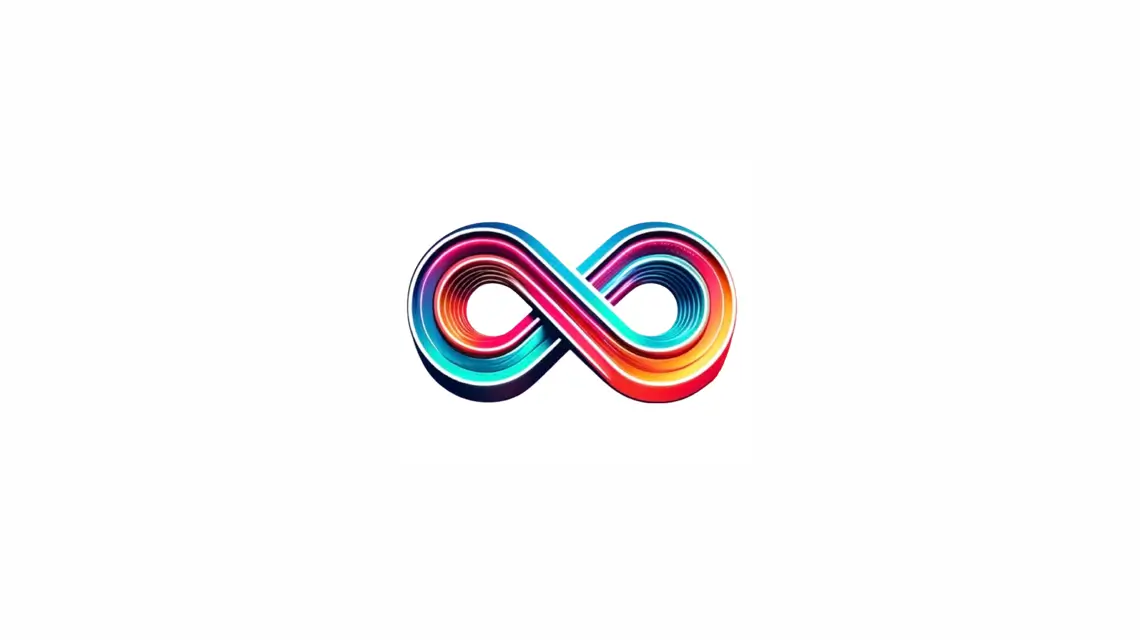Step into the world of luxury sparkling wine with yellow label champagne. This golden champagne captivates with its radiant hue and delicate effervescence. Each sip unveils a symphony of flavors, from zesty citrus to rich hazelnuts and toasty brioche.

The iconic yellow label adorning the deep green bottle creates a striking visual contrast. It’s a hallmark of prestige and quality in the realm of luxury sparkling wines. As you explore this golden elixir, prepare to be enchanted by its perfect balance of richness and minerality.
Key Takeaways
- Yellow label champagne is known for its golden color and fine bubbles
- It offers a balanced taste with citrus, hazelnut, and brioche notes
- The iconic yellow label on a dark green bottle creates visual appeal
- Golden champagne represents luxury and quality in sparkling wines
- This luxury sparkling wine balances richness with crisp minerality
The Legacy of Yellow Label Champagne
Veuve Clicquot’s iconic yellow label epitomizes quality and luxury in the champagne realm. Founded in 1772, this esteemed brand has solidified its status as a pivotal figure in the world of fine wines.
History of Iconic Yellow Labels
The origin of Veuve Clicquot’s yellow label traces back to Madame Clicquot, who assumed control in 1805. Her visionary leadership propelled the brand to global recognition, introducing the first single-vintage champagne in 1810. This pioneering move laid the groundwork for the iconic yellow label we admire today.
Evolution of Golden Bubbles
Veuve Clicquot’s dedication to excellence is evident in its rigorous production methods. The winemaking team meticulously produces 700-800 base wine samples each year, carefully selecting a blend from approximately 50 crus. This rigorous process guarantees the champagne’s consistent excellence.
Brand Heritage and Recognition
The acquisition by Louis Vuitton Moet Hennessy in 1986 catapulted Veuve Clicquot to global fame. Today, the brand oversees 390 hectares of vineyards, encompassing 12 out of 17 Champagne Grand Cru plots. This extensive vineyard coverage enables Veuve Clicquot to uphold its high standards, perpetuating its legacy of producing unparalleled champagne. For those interested in events, orange county party planning offers a variety of options to celebrate with luxury sparkling wine.
| Aspect | Details |
|---|---|
| Vineyard Coverage | 390 hectares |
| Grand Cru Plots | 12 out of 17 |
| Premier Cru Plots | 20 out of 44 |
| Grape Sourcing | 20% estate-owned, 80% from partners |
Understanding Yellow Champagne’s Unique Characteristics
Yellow champagne is distinguished by its striking champagne characteristics. Its golden hue immediately captures attention, accompanied by fine bubbles that rise elegantly to the surface. This visual appeal marks the beginning of a sensory adventure that encapsulates the essence of yellow champagne.
The color palette of yellow champagne spans from pale gold to deep amber. This range is influenced by the grape varieties used and the aging process. Chardonnay grapes impart a lighter shade, while Pinot Noir and Pinot Meunier contribute to the deeper tones of the golden hue.
Fine bubbles are a quintessential indicator of quality in champagne. In yellow champagne, these tiny pearls create a captivating foam at the surface. The size and longevity of these bubbles reflect the champagne’s quality and the aging process it has undergone.
| Characteristic | Description |
|---|---|
| Color | Golden hue ranging from pale to deep amber |
| Bubbles | Fine, persistent, forming a delicate foam |
| Aroma | Citrus, apple, hints of brioche or almond |
| Taste | Balanced freshness and forcefulness |
The taste profile of yellow champagne is a harmonious blend of freshness and intensity. It presents a subtle crispness alongside remarkable purity. This unique combination ensures a memorable drinking experience, solidifying yellow champagne’s status as a preferred choice for special occasions.
The Art of Production and Aging
Champagne production is a meticulous process that combines tradition with innovation. The varietal blend plays a crucial role in crafting the perfect yellow champagne. Let’s explore the key elements that contribute to its unique character.
Varietal Composition
Yellow champagne typically features a balanced blend of three grape varieties. The composition often includes 30% Chardonnay, 30% Pinot Noir, and 40% Meunier. This combination creates a harmonious flavor profile that appeals to champagne enthusiasts worldwide, making it essential for maximizing champagne budget.
Aging Process
The aging process is vital in developing the complex flavors of yellow champagne. Non-vintage champagnes must age for at least 15 months, while vintage varieties require a minimum of three years. Many producers extend these periods to enhance quality. During aging, bottles undergo a second fermentation, which can take several months to complete. For those looking to optimize their champagne experience, incorporating hosting tips can elevate any gathering.
Production Techniques
Yellow champagne production involves several key steps. The process begins with pressing, followed by blending, bottling, riddling-aging, and disgorging. Riddling is a crucial stage where bottles are gradually turned and tilted. An experienced riddler can handle up to 40,000 bottles daily, with each bottle taking 4-6 weeks to complete this process.
| Production Stage | Duration | Key Points |
|---|---|---|
| Pressing | 1-2 days | Only first 2,050 liters from 4,000 kg grapes kept |
| Blending | 3-4 months | Tasting committee refines choices multiple times |
| Bottling | 1-2 weeks | Second fermentation begins in bottle |
| Riddling-Aging | 15 months – 3 years | Bottles gradually turned and tilted |
| Disgorging | 1-2 days | Dosage added to determine sweetness level |
The final touch in champagne production is the dosage, which determines the sweetness level. This ranges from Extra Brut with less than 6 grams of sugar per liter to Doux with over 50 grams. The result is a golden-hued champagne with fine bubbles and a distinctive flavor profile.
Visual Appeal: The Golden Color Spectrum
Yellow champagne captivates with its golden champagne color and fine bubbles. This iconic beverage boasts a distinct visual charm that sets it apart from other wines. Let’s explore the elements that make yellow champagne a feast for the eyes.
Color Characteristics
The golden hue of champagne ranges from pale straw to deep amber. This spectrum includes 15 unique gold champagne color palettes, each evoking different moods. The champagne color (#F7E6CA) has RGB values of 96.9% red, 90.2% green, and 79.2% blue. This blend creates a warm, inviting appearance that’s instantly recognizable.

Bubble Formation and Quality
Fine bubbles are a hallmark of quality champagne. These tiny, persistent bubbles form delicate streams that rise to the surface, creating a mesmerizing display. The bubble quality depends on factors like fermentation and aging processes, contributing to the overall visual appeal and drinking experience.
Label Design Elements
The yellow label design is an integral part of champagne’s visual identity. Many brands feature a striking yellow label that complements the golden liquid within. Some special editions even incorporate electroluminescent elements, creating a glowing effect against the dark green bottle. This contrast enhances the champagne’s luxurious appearance, making it perfect for celebrations and special occasions.
Sensory Experience: Tasting Notes
Yellow champagne presents a captivating sensory experience, starting with its visually appealing color. The hues span from pale yellow to old gold, with bubbles that rise elegantly in the glass. This golden elixir prepares the palate for an unforgettable flavor profile.
The champagne’s tasting notes unveil a complex array of aromas and flavors. Upon inhaling, floral scents of white acacia and iris, along with citrus and fresh-cut grass, greet the senses. Upon tasting, the palate is greeted with a harmonious blend of white fruits, brioche, and vanilla.
The flavor profile of yellow champagne achieves a delicate balance between freshness and depth. Butter and biscuit dough intertwine with subtle fruit cake and toast notes, creating a rich tapestry of tastes. The acidity is refreshingly crisp, enhancing the overall drinking experience.
- Aroma: Floral, citrusy, grassy
- Taste: White fruits, brioche, vanilla
- Texture: Crisp acidity, balanced sweetness
- Finish: Well-developed, satisfying
This sensory journey concludes with a lingering aftertaste, varying from fleeting to long-lasting, depending on the champagne. Serving at 10°C to 12°C for vintage champagnes and prestigious champagne varieties ensures that every flavor nuance is fully expressed. This allows for a full appreciation of each sip.
The Perfect Blend: Grape Varieties
Champagne’s allure stems from its unique blend of grape varieties. The three primary champagne grape varieties – Chardonnay, Pinot Noir, and Meunier – form the backbone of this sparkling wine’s character.
Chardonnay Influence
Chardonnay brings freshness and elegance to champagne. It covers about 28% of the Champagne region’s vineyards. Chardonnay thrives in prestigious villages like Avize, Le Mesnil-sur-Oger, and Cramant. This grape variety contributes crisp acidity and floral notes to the blend.
Pinot Noir Contribution
Pinot Noir, the most widely planted grape in Champagne, represents 38% of the region’s vineyards. It’s prominent in Montagne de Reims, Vallée de la Marne, and Côte des Bar. Pinot Noir adds body, structure, and red fruit flavors to champagne.
Meunier’s Role
Meunier, accounting for 34% of Champagne’s vineyards, is mainly grown in the Marne Valley and Aube. It adds roundness and an unctuous texture to the blend. Meunier contributes fruity aromas and helps balance the other varieties.
| Grape Variety | Vineyard Coverage | Key Contribution |
|---|---|---|
| Chardonnay | 28% | Freshness, Elegance |
| Pinot Noir | 38% | Body, Structure |
| Meunier | 34% | Roundness, Fruitiness |
The art of blending these varieties creates the distinctive taste of champagne. While some cuvées use a single grape variety, over 90% of champagnes are blended. This showcases the winemaker’s skill in balancing these unique grape characteristics.
Aromatic Profile and Flavor Components
Yellow champagne presents a captivating tasting profile that engages the senses. Its champagne aromas explode with complexity, beckoning exploration of its depth. Let’s explore the intricate flavor components that make this golden elixir unique.
Fruity Notes
The fruity essence of yellow champagne is a cornerstone of its appeal. You’ll find a medley of white and yellow fruits, with crisp apple and juicy pear hints. Some varieties introduce red and black fruit notes, enriching the flavor palette. Citrus undertones add a refreshing zest, while exotic fruit hints introduce an intriguing twist.
Floral Elements
Delicate floral notes enhance the champagne’s bouquet. Roses and peonies contribute a subtle sweetness, while violets add elegance. These floral elements blend with fruit flavors, creating a harmonious blend that dances on the palate.
Spice Undertones
Spice notes add depth and complexity to yellow champagne and sparkling rose. Gentle hints of cinnamon and cloves might surprise your taste buds, offering a warm and inviting finish. These subtle spice undertones complement the fruit and floral components, resulting in a well-rounded tasting experience.
The interplay of these flavor components creates a champagne that’s both sophisticated and approachable. Each sip reveals new layers of taste, making yellow champagne a true delight for wine enthusiasts and casual drinkers alike.
Food Pairing and Serving Suggestions
Yellow champagne stands out as an aperitif, complementing a wide array of dishes. Its adaptability makes it ideal for both casual and formal dining. To fully appreciate its nuances, it’s crucial to explore the best champagne food pairing options and the optimal serving temperature.
Begin your meal with yellow champagne at 45-48°F (7-9°C). This temperature enhances the wine’s crisp acidity and effervescent bubbles. It prepares your palate for the culinary delights that follow.

Yellow champagne’s balanced profile pairs well with various flavors. Here are some exciting combinations to try:
- White meat dishes like roasted chicken or turkey
- Seafood options such as grilled white fish or oysters
- Creamy pasta dishes or risottos
- Light appetizers like goat cheese crostini or prosciutto-wrapped melon
For a unique yet delightful pairing, consider yellow champagne with macaroni and cheese. The wine’s acidity balances the richness of the cheese, creating a delightful harmony.
| Champagne Style | Food Pairing Suggestion |
|---|---|
| Brut | Sushi, shellfish, light salads |
| Extra Dry | Fruit-based desserts, mild cheeses |
| Demi-Sec | Foie gras, blue cheese, desserts |
The serving temperature significantly influences your enjoyment of yellow champagne. If it’s too cold, you’ll miss its subtle flavors. If it’s too warm, it may taste flat. Aim for 45-50°F (7-10°C) to fully appreciate its complexity and effervescence.
Storage and Preservation Tips
Proper champagne storage is essential for maintaining its quality and extending its aging potential. Grasping the appropriate preservation techniques is vital to keep your champagne in optimal condition for extended periods.
Temperature Control
Champagne excels in cool environments. For brief storage, maintain it at 8-10°C within the fridge. For longer storage, a consistent temperature of 10-13°C is necessary. This temperature range preserves the wine’s quality and hinders premature aging.
Positioning Requirements
For short-term use, store champagne bottles upright to keep the cork moist. For extended storage, lay them on their side. This method prevents the cork from drying out, thus maintaining the seal.
Aging Potential
Non-vintage champagnes generally last 3 to 5 years, whereas vintage champagnes can age up to 15 years. Magnums are ideal for aging due to their slower maturation process. Laurent Perrier La Cuvee has an aging potential of 3 to 5 years, while Laurent Perrier Grand Siècle can age up to 15 years.
| Champagne Type | Aging Potential | Ideal Storage Temperature |
|---|---|---|
| Non-Vintage | 3-5 years | 45°F to 50°F |
| Vintage | Up to 15 years | 45°F to 50°F |
| Laurent Perrier Grand Siècle | Up to 15 years | 45°F to 50°F |
It’s crucial to maintain humidity levels between 70% to 85% for champagne storage. This range prevents cork drying and oxidation, ensuring your champagne remains vibrant and delicious for years to come.
Special Occasions and Celebrations
Yellow champagne is the epitome of luxury during special moments. Its golden hue and delicate bubbles make it the quintessential choice for champagne celebrations. Whether it’s a wedding or New Year’s Eve, this effervescent elixir brings a touch of opulence to any occasion.
Champagne’s allure in toasting is rooted in its refined presentation and exquisite taste. The secondary fermentation process imbues it with the signature bubbles that grace your glass, enhancing the luxury of any event. Whether indulging in a non-vintage blend or a vintage selection, each bottle narrates a unique tale.
For those desiring the pinnacle of elegance, brands like Dom Pérignon and Veuve Clicquot epitomize sophistication. These esteemed labels command premium prices, a testament to their dedication to quality and tradition. For a more budget-friendly option, California producers such as Korbel and Mumm Napa offer sparkling wines that emulate champagne’s essence at a lower cost.
| Champagne | Annual Production | Price Range |
|---|---|---|
| Charles Heidsieck Brut Reserve | 1 million bottles | $97 |
| Philipponnat Royal Reserve Brut | 500,000 bottles | $85 |
| Louis Roederer Vintage Rosé | 1 million bottles | $135 |
| Laurent-Perrier Rosé | 7 million bottles | $130 |
Remember, when celebrating, champagne offers a symphony of flavors. From zesty citrus to luscious orchard fruits, creamy textures to nutty undertones, each sip is a journey. So, next time you’re planning a special event, consider the golden bubbles of yellow champagne to elevate your toasting experience.
Global Recognition and Export Quality
Yellow champagne has achieved worldwide acclaim for its unparalleled quality and distinctiveness. The champagne export sector has witnessed a significant expansion, with global markets enthusiastically embracing this golden nectar. Australia, in particular, has emerged as a leading example, ranking as the world’s sixth-largest champagne market.
International Markets
Australia’s champagne consumption has skyrocketed, increasing tenfold since 2001. This exponential growth in demand underscores the global allure of yellow champagne. The country holds the distinction of having the highest per capita consumption outside of Europe, demonstrating the beverage’s international appeal.
Quality Standards
In the champagne industry, quality assurance is of utmost importance. The Vin de Champagne Awards, now in its 43rd edition, honors excellence in champagne knowledge and appreciation. This esteemed competition features blind tastings of mystery champagnes, judged by previous winners. The rigorous selection process ensures that only the finest champagnes are exported to international markets.
Shipping Considerations
Proper shipping is essential to preserve the integrity of exported champagne. Producers meticulously ensure their products arrive at their destinations in pristine condition. This meticulous attention to detail has been instrumental in the success of champagne exports globally, with countries like Australia witnessing a substantial increase in imports.
| Country | Champagne Market Rank | Consumption Growth | Notable Awards |
|---|---|---|---|
| Australia | 6th Largest | 10x increase since 2001 | Vin de Champagne Awards |
| England | Growing Producer | 4,000 hectares under vine | International Wine Challenge |
| United States | Major Importer | Steady growth | Various international awards |
Conclusion
Yellow champagne, with its golden bubbles, captivates wine enthusiasts globally. The Veuve Clicquot Yellow Label Brut Non Vintage exemplifies the art of blending. Its composition has evolved over decades, maintaining a consistent blend of roughly 50-55% Pinot Noir, 15-20% Pinot Meunier, and 28-33% Chardonnay from 1953 to 2007.
The Bollinger Special Cuvée stands out with a blend predominantly of 60% Pinot Noir, offering a bolder, more structured taste. In contrast, Veuve Clicquot’s balanced blend creates a harmonious mix of fruitiness and subtlety. This makes it elegantly drinkable and highly sought after.
Yellow champagne’s versatility in food pairings is noteworthy. Veuve Clicquot pairs well with light starters like smoked salmon canapés. Bollinger, on the other hand, complements heartier dishes such as aged cheeses and mushroom risotto. This adaptability, along with their rich histories and complex flavors, solidifies yellow champagne’s status as a luxury in the sparkling wine world.
RelatedRelated articles



